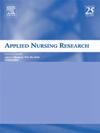Text-based fall prediction in hospital: Development and internal validation of a model to predict in-hospital falls in older patients using free text from daily nursing records
IF 2.2
4区 医学
Q1 NURSING
引用次数: 0
Abstract
Aim
The aim of this study was to evelop a predictive model, estimating the probability of an in-hospital fall using previously identified associated words, and word combinations in daily nursing records. To assess the difference in discriminatory ability between the predictive model and currently used screening questions.
Background
Hospital falls are a persistent challenge. Identifying patients at high risk before fall incidents occur is essential to optimize preventive measures and reduce the burden on nursing staff.
Method
Words from daily nursing records were used as predictive variables to construct and validate the model. The DeLong's test was used to determine statistical differences between the developed model and the current screening questions.
Results
A total of 3255 consecutive admissions of patients aged 70 and over were included, of whom 110 experiences a fall. Upon internal validation, the predictive text model demonstrated moderate discriminatory ability (AUC-ROC 0. 737 (CI 95 % 0. 683–0.791)) and good calibration across a range of the risk groups. Compared to the screening questions (AUC-ROC 0.603 (CI 95 % 0.555–0.652)) the text model (AUC-ROC 0.734 (CI 95 % 0.679–0.788)) showed significantly better discriminatory ability (DeLong's − 3.93, p ≤0.001).
Conclusion
Daily nursing records can be used to estimate the probability of in-hospital falls. A text-based predictive model outperforms the currently employed screening questions and provides insights for the efficient use of fall prevention interventions. Further research should focus on improving the accuracy and external validation of the model and implementation strategies.
基于文本的住院跌倒预测:利用日常护理记录中的免费文本预测老年患者住院跌倒的模型的开发和内部验证
目的本研究的目的是建立一个预测模型,使用先前识别的相关单词和日常护理记录中的单词组合来估计住院跌倒的概率。评估预测模型与目前使用的筛选问题在区分能力上的差异。医院跌倒是一个持续的挑战。在跌倒事件发生之前识别高危患者对于优化预防措施和减轻护理人员的负担至关重要。方法以日常护理记录为预测变量,构建并验证模型。使用DeLong检验来确定开发的模型与当前筛选问题之间的统计差异。结果共纳入3255例70岁及以上连续入院患者,其中110例发生跌倒。经内部验证,预测文本模型具有中等的区分能力(AUC-ROC为0。(ci 95%);683-0.791))和在一系列风险组之间进行良好的校准。与筛选题(AUC-ROC 0.603 (CI 95% 0.555-0.652))相比,文本模型(AUC-ROC 0.734 (CI 95% 0.679-0.788))具有更好的区分能力(DeLong’s - 3.93, p≤0.001)。结论日常护理记录可用于评估住院跌倒的发生概率。基于文本的预测模型优于目前使用的筛选问题,并为有效使用预防跌倒干预措施提供了见解。进一步的研究应侧重于提高模型和实施策略的准确性和外部验证。
本文章由计算机程序翻译,如有差异,请以英文原文为准。
求助全文
约1分钟内获得全文
求助全文
来源期刊

Applied Nursing Research
医学-护理
CiteScore
4.50
自引率
0.00%
发文量
65
审稿时长
70 days
期刊介绍:
Applied Nursing Research presents original, peer-reviewed research findings clearly and directly for clinical applications in all nursing specialties. Regular features include "Ask the Experts," research briefs, clinical methods, book reviews, news and announcements, and an editorial section. Applied Nursing Research covers such areas as pain management, patient education, discharge planning, nursing diagnosis, job stress in nursing, nursing influence on length of hospital stay, and nurse/physician collaboration.
 求助内容:
求助内容: 应助结果提醒方式:
应助结果提醒方式:


